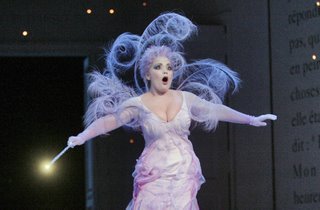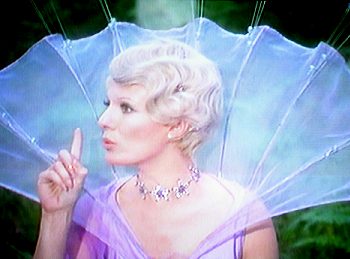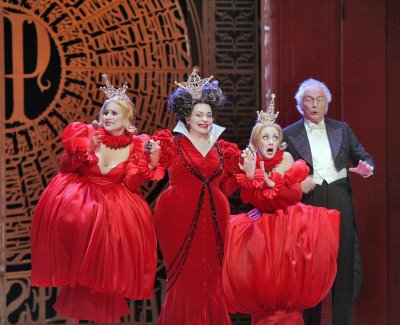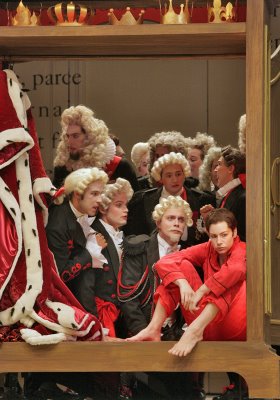
Joyce DiDonato as Cendrillon and Eglise Gutierrez as La Fée, Cendrillon, Santa Fe Opera, directed by Laurent Pelly, sets by Barbara de Limburg, costumes by Laurent Pelly and Jean-Jacques Delmotte, photo by Ken Howard © 2006 |
It has been an extraordinary week here at the
Santa Fe Opera, and I have heard a number of excellent performances. Last night, however, I saw the
new production of Massenet's Cendrillon, and it is an overwhelming triumph. This charming opera is a favorite of mine, and I wrote about it last year in a
minor production in Washington (in a chopped up and modernized version with the prince sung by a tenor). The Santa Fe staging is a near-perfect combination of stupendous singing and playing and an inventive and beautiful design. The French connection strikes again, after Natalie Dessay's superb Pamina in
The Magic Flute and Laurent Naouri's vainglorious Escamillo in
Carmen. In
Cendrillon, it is director Laurent Pelly, whose thrilling and sometimes over-the-top productions at the
Opéra de Lyon and the
Théâtre du Châtelet have become infamous. He and his colleagues have created a
Cendrillon that is at once a fairy tale, connected quite literally to the source of the
libretto by Henri Cain -- Charles Perrault's 1697 story
Cendrillon, ou la petite pantoufle de verre, reproduced in large print on the walls of the set and some of the costumes -- and a modern, almost minimalistic design.

Eglise Gutierrez as La Fée, Cendrillon, Santa Fe Opera, directed by Laurent Pelly, costumes by Laurent Pelly and Jean-Jacques Delmotte, photo by Ken Howard © 2006 |
I have always liked the
soprano léger role of La Fée (the Fairy Godmother), one of several that Massenet created with the voice of talented American soprano Sibyl Sanderson in mind. He heard her sing the Queen of the Night's arias at a dinner party and composed the title roles in his remarkable but mostly forgotten opera
Esclarmonde (1889) and the celebrated
Thaïs (1894) specifically for her. He had completed
Cendrillon by 1896, probably with Sanderson cast in his thoughts, but the opera was not premiered until 1899, at the Opéra-Comique, and Sanderson did not create the role. As I think the gorgeous
poster for the first production indicates, Massenet thought of La Fée as the central role. The coloratura voice is a natural fit for a magical entity, also used to great effect by
Mozart for the Queen of the Night and by
Thomas Adès for Ariel, and La Fée's silvery roulades and sparkling vocal flashes are indeed memorable, setting the fairy tale tone for Perrault's
conte de fées in music.

Delphine Seyrig as the Fée des Lilas, Peau d'âne (1970), directed by Jacques Demy |
The fabulous -- in the truest sense of that word, as in the Latin
fabulosus -- costumes in this production are credited to Laurent Pelly and Jean-Jacques Delmotte. To my eye, La Fée's purple costume, with curly feathers in a fan behind her head, was inspired by a film source that I would expect was an influence on Laurent Pelly, the Fée des Lilas (Lilac Fairy) in Jacques Demy's
Peau d'âne. Pelly and Delmotte's costumes are several degrees less kitschy -- in Demy's, they are very 70s -- but I think the comparison is a just one, even if the relationship of the production to the movie was unintended. Once you have seen
Peau d'âne, one's conception of fairy tales is stood on its head, as Demy's film does something quite similar to Pelly's staging, keeping a traditional view of the fairy tale while simultaneously updating it in modern psychological terms. The heroine's father, a widower king, ends up married to the Fée des Lilas at the end, which is much of what fairy godmothers are all about, I think.

Gabriela Garcia as Dorothée, Judith Forst as Madame de la Haltière, Anne-Carolyn Bird as Noémie, and Richard Stilwell as Pandolfe, Cendrillon, Santa Fe Opera, directed by Laurent Pelly, sets by Barbara de Limburg, costumes by Laurent Pelly and Jean-Jacques Delmotte, photo by Ken Howard © 2006 |
The opera has some beautiful dramatic moments that deserve to be presented seriously, as they were here, especially the gorgeous solo pieces for Cendrillon and the glorious duets with Le Prince Charmant. However, it is mostly a light-hearted and rather silly comic opera, a characteristic that Pelly's staging plays to the hilt. The costumes of the other princesses who compete for the prince's attention are too zany to be believed, complete with absurd choreography (by Laura Scozzi) that is a delicious mockery of the stilted manners and stylized dancing of the French
grand siècle court. For a mostly American audience (as regular readers know, we francophiles am not happy to be in the land of freedom fries and cheese-eating surrender monkeys), Pelly's send-up of French stereotypes was hilarious, but it is hard to predict how a French audience would react to the Prince's mincing attendants, leapingly light in their loafers. I would guess that, given the antiroyalist sympathies of most French people, audiences at the Châtelet (for this production surely must go there and hopefully many other houses) will be similarly entertained. The malice of the stepmother and stepsisters is underscored by their misshapen costumes, ridiculously plump in the center and then constricting again around the ankles, which modifies the way the singers walk in amusing ways.
The various sets and effects were luscious and magical. In the sleep ballet in Act I, tiny starlike lights twinkle from the walls among Perrault's words, as the troop of servants in the starkly empty house become the sprites and fairies who attend La Fée, disappointingly without any change of costume. The carriage, its shape derived from the French word for carriage, is drawn by two supernumeraries with horse heads. At scene changes, the walls angle backward and forward to create new spaces. Rolling set pieces make entrances and exits through the paired doors on either side to create a balcony, Cendrillon's dingy attic bedroom, and a Paris rooftop of smoking chimneys. The latter, mysteriously, is the setting of the second
tableau of Act III, the enchanted garden where Cendrillon and Le Prince Charmant meet -- described in the libretto as "
Chez la Fée (Un grand chêne au milieu d'une lande pleine de genêts en fleurs. Au fond: la mer - nuit claire - lumière très bleutée)." It was a beautiful scene, but the absence of an oak tree, which is supposed to prevent the lovers from seeing one another and is mentioned several times by the singers, made a hash of it.

Jennifer Holloway as Le Prince Charmant with ensemble, Cendrillon, Santa Fe Opera, directed by Laurent Pelly, sets by Barbara de Limburg, costumes by Laurent Pelly and Jean-Jacques Delmotte, photo by Ken Howard © 2006 |
Nothing of this marvelous staging would be worth a candle without the knockout singing of Santa Fe's stellar cast. The rich, velours mezzo-soprano of Joyce DiDonato, a one-time apprentice at Santa Fe, purred and rocketed in the title role. In the moving duets, Jennifer Holloway -- an apprentice at Santa Fe benefitting from a dream career break -- was a slightly smaller-voiced but well-matched complement to DiDonato. Holloway's transformation from beautiful woman to prince, by way of a short haircut and the most convincing imitation of male movement I have ever seen on stage, is a miracle. People near me in the audience were visibly surprised to hear a woman's voice emanate from the young man in the red pajamas in her first scene.
Baritone Richard Stilwell -- a regular in Santa Fe for 30 years -- was a dry-wit Pandolfe, a perfectly timed foil to the imperious stepmother of mezzo-soprano Judith Forst, who made her first appearance at Santa Fe at around the same time as Stilwell. Apprentices
Anne-Carolyn Bird and Gabriela Garcia were hysterical as the stepsisters -- Noémie (soprano) and Dorothée (mezzo-soprano), respectively -- with facial expressions, gestures, and vocal characterization evoking the vapid airheads the stepsisters are (not the singers). I was disappointed only with Eglise Gutierrez, a very talented singer whose meaty dramatic soprano did not strike me as well suited to the silvery role of La Fée (her recent work has included Gilda and
Turandot Liù, which seem much more appropriate to the fuller body of her voice). The fine supporting singers and the superb dancers rounded out the excellent cast.
Performances of
Massenet's Cendrillon are scheduled for August 9, 18, 21, and 24. If you can see only one opera in Santa Fe this summer, this is the one. If you can see two, then pair it with
The Tempest.


























































4 comments:
Dear Sir, I agree with most of what you have written. But wouldn't it be nice if you had mentioned the excellent orchestra?
NB
NB, thank you for that addendum. I did not mean to slight by omission. Kenneth Montgomery led a suave performance by the orchestra, too. All those wind solos created a terrific magical atmosphere.
While I enjoyed reading your review, my own sentiments could not be more different.
I found the staging arch and heartless - with very awkward transitions between all that brittle mockery and the gorgeous love arias. The costumes seemed merely cartoonish, and the all that mincing and mugging was utterly exhausting to watch.
However, it was, as you say, beautifully played and beautifully sung. But, for me, that did not really compensate for a rather long and tiresome evening in the theater.
The Tempest, on the other hand, was spectacular!
AC
AC, thanks for adding your perspective. De gustibus...
Post a Comment